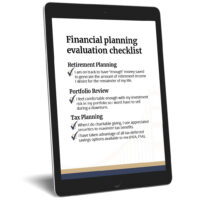
Tax planning strategies every high earner should know for 2025
Tax planning can feel overwhelming, but ignoring it could cost you. With the right approach, planning ahead can lead to significant savings—though it requires strategy and foresight. Start planning now to avoid common tax mistakes and keep more of what you earn. Here are eleven actionable tips to help you get started.
Major tax proposals that could affect your taxes
Before diving into strategies, take note of key tax proposals that could impact your finances in 2025.
Major provisions from the 2017 Tax Cuts and Jobs Act (TCJA) are set to expire on December 31, 2025. But with Former President Donald Trump returning to the presidency on January 20, 2025, many of these changes may be extended.
While the details remain uncertain, here are some of the possibilities floated in the lead up to the new administration:
- Reduction of the corporate income tax rate from 21% to 20% (and as low as 15% for corporations that make their products in the U.S.)
- Federal tax exemptions for tips, overtime pay, and Social Security income
- A new itemized deduction for interest on auto loan payments
- Removal of the $10,000 cap on state and local tax (SALT) deductions
- Doubling the child tax credit from $1,000 to $2,000
These proposals could have a meaningful impact on your tax situation, so it’s important to factor them into your 2025 planning. Now, let’s explore actionable steps to take advantage of these potential changes.
11 actionable 2025 tax planning tips for high earners
1. Maximize retirement contributions
Contributing the maximum amount to retirement accounts like 401(k)s, IRAs, and SEP IRAs lowers your taxable income while helping you save for retirement. If you’re aged 50 or over, you can also make “catch-up contributions” beyond the usual limit to boost savings during these important pre-retirement years.
For 2025, the contribution limits are;
- 401(k): $23,500, plus $7,500 catch-up (for people aged 50 – 59) and a brand new $11,250 catch-up (for people aged 60-63)
- IRAs: $7,000 plus $1,000 catch-up for people aged 50+
If you’re a business owner, consider these limits:
- SEP IRAs: 25% of eligible employee compensation up to $70,000
- SIMPLE: $16,500, with catch-up contributions of $3,500 (ages 50-59) and $5,250 (ages 60 – 63)
2. Use the increased gift and estate tax exemptions
In 2025, you’ll have a opportunity for tax-exempt wealth transfer. Here’s what you need to know:
- The gift and estate tax exemption will reach $13.99 million per individual in 2025.
- The annual gift tax exclusion will increase to $19,000 per recipient.
- Married couples can gift up to $38,000 per recipient annually without using their lifetime exemption.
These high exemptions are set to expire at the end of 2025. Without Congressional action, the lifetime exemption could revert to approximately $7 million (when adjusted for inflation) in 2026, making 2025 a crucial year for estate planning.
For example, if you and your spouse have three children and five grandchildren, you could transfer $304,000 in 2025 using only the annual exclusion, leaving your entire $27.98 million combined lifetime exemption intact for larger wealth transfers.
Consider these strategies:
- Use the increased lifetime exemption for substantial gifts before the potential decrease.
- Gift assets with high appreciation potential to remove future growth from your taxable estate.
- Explore irrevocable trusts for additional tax and asset protection benefits.
While you can always make tax-free gifts up to the annual exclusion amount, the opportunity to use such a high lifetime exemption may be limited. By strategically using these exemptions in 2025, you can significantly reduce your taxable estate and optimize wealth transfer to your beneficiaries.
3. Harvest investment gains and losses
If you’ve made a profit on some investments, consider selling others at a loss to reduce your capital gains tax liability.
Short-term gains are taxed at your ordinary income rate (up to 37% in 2025).Long-term gains are taxed at preferential rates (0%, 15%, or 20% depending on your income). By strategically harvesting losses, you can potentially save significant amounts on taxes, especially if offsetting short-term gains.
After offsetting capital gains, you can use up to $3,000 ($1,500 if married filing separately) of excess losses to offset annual ordinary income. If losses exceed this limit, they can be carried forward to future tax years. This strategy balances your investment portfolio while keeping taxes in check.
In general, you should review your investment portfolio regularly (at least annually) and consider rebalancing to keep it aligned with your desired risk level.
4. Plan for state and local tax (SALT) deductions
The potential removal of the $10,000 SALT cap is a major win for those in high-tax states like California. This change would allow you to fully deduct state and local taxes, helping to reduce your federal tax bill.
If you’re a business owner or investor receiving K-1 income from a partnership or LLC (rather than W-2 income), passthrough entity taxes offer an additional opportunity to bypass deduction limits. By opting for this structure, you can ensure that state and local taxes are treated more favorably.
Understanding these changes and adjusting your finances accordingly could make a significant difference in what you owe come 2025.
5. Bunch charitable contributions
In 2025, consider bundling multiple years of charitable donations into a donor-advised fund (DAF). This allows you to exceed the standard deduction and maximize your tax benefits. By making a larger upfront donation, you can claim a bigger deduction right away, even if your usual annual contributions don’t surpass the standard deduction. You can then distribute the funds to charities over time directly from the DAF.
This strategy is ideal if you have strong charitable intentions. It lets you support the causes you care about while staying tax-efficient.
6. Review and adjust withholdings
Make sure your tax withholdings align with your expected tax liabilities for 2025 to avoid overpaying or underpaying. Adjusting withholdings means updating the amount of federal income tax withheld from your paycheck. Too much withheld results in a refund, but essentially gives the government an interest-free loan. Too little withheld leads to penalties.
To adjust, complete a new IRS Form W-4 and submit it to your employer. If you’re a business owner with fluctuating income, you can avoid penalties for underpayments by making sure your estimated quarterly payments align with income received.
7. Consider timing income and deductions
Timing your income and deductions can help optimize your tax bracket and minimize what you owe. If you anticipate a significant change in your income in 2025 or 2026, adjust the timing of income and deductions accordingly. For example, delaying bonuses or shifting deductible expenses to 2025 can lower taxable income. Alternatively, accelerating income into a lower-tax year may also be beneficial. A tax advisor can help you make these adjustments strategically to reduce taxes over both years.
8. Evaluate alternative minimum tax (AMT) exposure
The Alternative Minimum Tax (AMT) ensures high earners pay a baseline tax by applying higher rates (26% or 28%) and disallowing certain deductions like state taxes or interest. It can be triggered by factors such as high income, exercising Incentive Stock Options (ISOs), or tax-exempt interest from specific bonds.
To calculate AMT, add back disallowed deductions to your income, subtract the exemption amount, and apply the AMT rate. You pay the higher of your regular tax or AMT liability.
Effective tax planning can help manage your AMT exposure. For example, spread ISO exercises over multiple years to reduce AMT impact, as the difference between market value and exercise price counts as income under AMT rules. Consider the timing of deductions and investments like private activity bonds. Consulting a financial advisor can help project your AMT liability and develop strategies to avoid unexpected tax bills.
9. Optimize your homeownership tax strategies
 You probably know you can deduct mortgage interest with certain limits, potentially saving you thousands on taxable income. But did you know that tracking home improvement costs can also pay off? Certain home improvements, ranging from clean energy to medically necessary updates and more increase your home’s cost basis, which lowers taxable gains when you sell. Be sure to clarify which improvements fit the tax code.
You probably know you can deduct mortgage interest with certain limits, potentially saving you thousands on taxable income. But did you know that tracking home improvement costs can also pay off? Certain home improvements, ranging from clean energy to medically necessary updates and more increase your home’s cost basis, which lowers taxable gains when you sell. Be sure to clarify which improvements fit the tax code.
Take time to review your homeownership tax strategies to make the most of these benefits, especially if you’re considering selling your property in 2025 or later.
10. Plan for net investment income tax (NIIT)
If you have income from investments, you may be subject to net investment income tax.
If your income is also above the statutory threshold amounts, you might be subject to the 3.8% Net Investment Income Tax (NIIT). Threshold amounts include,
- Single or head of household $200,000
- Married or filing jointly S250,000
- Married filing separately $125,000
- Qualifying widow(er) with dependent children $250,000
To lower this NIIT, consider investing in tax-exempt options like municipal bonds. Alternatively, participate in rental real estate to avoid the NIIT on rental income. As always, review and adjust your investment strategy with your financial advisor to minimize the NIIT’s impact on your 2025 taxable income.
Proactively planning for the NIIT ensures you keep more of your investment earnings and reduces the overall impact on your taxable income in 2025.
11. Explore end-of-year Roth conversions
Roth conversions allow you to transfer funds from traditional retirement accounts (like IRAs or 401(k)s) into a Roth IRA. While you’ll pay taxes on the converted amount this year, the strategy offers several benefits:
- Tax-free growth on future withdrawals
- Ability to strategically convert amounts that keep you within your current
- No required minimum distributions (RMDs) in retirement
- Beneficiaries inherit Roth IRAs tax-free
- Flexibility to manage taxable income with both traditional and Roth accounts
- Potential long-term tax savings if you’re in a higher tax bracket later
- Option to spread conversions over multiple years
Whether or not to utilize this strategy is dependent upon your personal situation. Many considerations go into the decision to pursue this strategy. Reach out to us to determine whether a Roth conversion is right for you.
Tax planning doesn’t have to be overwhelming
With some planning and preparation, you can save money on taxes and keep more of your wealth where it belongs. From maximizing retirement contributions to optimizing homeownership strategies, these tips help you make the most of new and existing tax policies.
Don’t wait until tax season—start planning today. Consult with one of our CERTIFIED FINANCIAL PLANNER™ professionals to create a strategy that aligns with your overall financial goals. We’ll work with your tax preparer or accountant to help make sure you balance tax benefits with your long-term financial security.
The information provided herein is for informative and educational purposes only. The use of hyperlinks to third party websites is not an endorsement of the third party. Third party content has not been independently verified. To understand how this content may apply to you, please contact a financial advisor.






